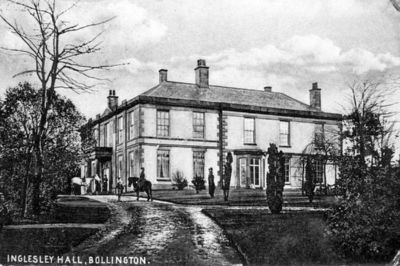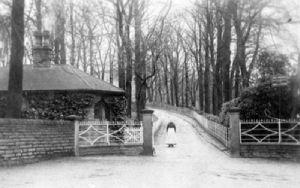
Ingersley Hall (now Savio House)
In 1768 John Gaskell (1743-1824), Tower House Rainow bought five farms in the vicinity of Sowcar one of which was Ingersley Farm, this area and buildings before was once owned by Jackson Of Hurdsfield to whom ‘Thomas Jackson of Ingersley’ was living in 1658 and 1662. John Gaskell built the first part of Ingersley Hall in 1774 (see Gaskells). Although often associated with Bollington it actually lies just across the boundary in the parish of Rainow. The land had first been acquired by John Gaskell’s grandfather in about 1750, then passed to his father who lived at Sowcar [Soo-ka], but due to the disputed nature of the way in which the land had been granted (from the bankrupt Downes of Shrigley) it had not been possible previously to build on it. The house John Gaskell constructed was modest, with three bays only, in the fashionable Georgian style with pleasing proportions and sash windows, built adjacent to the farm house and buildings previously occupied by the Gaskell family. (The farmhouse was built by Jacksons of Hurdsfield date not known, but one of whom Thomas Jackson lived there in 1658. Later it was purchased by John Gaskell senior). The House was known initially as Ingersley House. Access at first was not from the driveway we know today that leads from the top of Ingersley Road at the point once known as Gaskell’s Gate, but from the ancient route of Oakenbank Lane, now a bridle path.

When the new tree-lined drive was constructed, some time in the 1820s, a lodge (left), now demolished, was built at the gateway. And records show that in 1851 Thomas Wright a Coachman aged thirty three years and his wife Emma aged twenty nine years lived here with their three young children. In the 1939 census Hannah Berry was the `Lodge Keeper`.
John’s son Thomas inherited Ingersley but it was his son, John Upton Gaskell, who extended it, eventually to three times its original size, and renamed it Ingersley Hall. In 1833 he added an imposing north facing frontage in the Greek revival style complete with a Doric porch. Later he extended it also on the south side, and when completed it had twenty eight rooms including a ballroom and cellars below. In the 1850s John Upton also built a conservatory on the south side of the house (below), erected grandiose new stables and a coach house, improved the adjacent farm and farm buildings, and developed the gardens and parkland.

His daughter Anne Theodora was the last permanent Gaskell resident and in 1933, ten years after her death, all the contents were auctioned in a sale that lasted six days and the house was put up for sale. It was bought by Edward Lomas, a silk manufacturer and a Roman Catholic of a philanthropic bent. He intended it to be used by the Sisters of Mercy of Notre Dame and put in place a comprehensive refurbishment process. However, on 6th March 1937 a disastrous fire broke out and devastated a large part of the building, including the great staircase. Eventually, in 1952, Lomas sold the building to the Catholic order of the Salesians of Don Bosco, whose premises at Shrigley Hall Hotel had become inadequate for their needs. They made numerous alterations to the interior of the building, including installing electricity and fashioning a chapel on the first floor, and converted and extended most of the outbuildings. They renamed it Savio House, after a famous Salesian pupil, St Dominic Savio, who died in Turin aged 15 years and was sanctified for his piety and compassion.
Ingersley Hall, by then Savio House, was listed Grade II in 1967, as was the original farmhouse and the former coach house, despite the central archway having been filled in by the Salesians.
Census
1841: Mary Upton Gaskell aged sixty five years and from Lancashire, lived at the hall. Also living with her were her adult offspring Frances aged twenty five years, Harriet and Richard both aged twenty years, (all Rainow born) and finally there were two servants living at the Hall.
1851: Mary Upton Gaskell was still resident at Ingersley Hall and by now a farmer of forty acres. Her daughters Frances and Harriet were still with her. They had three servants from Staffordshire, a coachman from Clinton in Derbyshire and a gardener from Poynton in Cheshire.
1871: John Upton Gaskell, aged sixty six years, lived at Ingersley Hall with his wife Margaret Elizabeth (nee Grimshaw of Errwood Hall, Goyt Valley) aged fifty seven years. Also living there was Anne Theodora, their daughter aged twenty five years (born at Endon Hall), and their son John aged nineteen years, plus four servants. John had been listed as living at Ingersley `House` on the 1851 census with his family. Presumably this was next to Ingersley Hall.(?)
1881: John Upton Gaskell was still at Ingersley Hall and was aged seventy six years. His wife Margaret was by now, sixty seven years old. They lived with their daughter Anne Theodora, aged thirty six years. There were three servants. John died two years after this census leaving £4,513 to his wife Margaret.
1898: Anne Theodora Gaskell was still living a Ingersley Hall according to the Electoral Roll.
1911: Anne Theodora Gaskell was now aged sixty six years and was the Mistress of the house. Also living there was Mary Alice Caroline Caterall, aged fifty four years. She was described as a lady companion and was born in Preston, Lancashire. Similarly forty one year old Ethel Surplice from Rangoor, Burmash, also shared the house. A visitor named Helen Scott from Monkstown, Ireland, also aged forty one, was at the Hall on this day. There were six servants at this time. All ten residents, bar one, were single females. The only man was forty nine year old Walter James Newland from Statford On Avon, he was described as a Man Servant!

Acknowledgements
This page is extracted, with the author’s generous assistance and permission, from The Gaskells of Ingersley Hall by Bridget Franklin. Copies available from the Discovery Centre .
The monochrome pictures are courtesy of the Discovery Centre archive. The colour picture is by the kind permission of Rainow Image Library.
Our thanks go to Linda Stewart who has researched census information to present an interesting history of the house’s residents.
Your Historic Documents
Please don't chuck out those historic documents and pictures! Find out why here.